Tupolev Tu-204

Tupolev Tu-204

| Tu-204 / Tu-214 | |
|---|---|
| A Red Wings Tu-204-100 on final approach | |
| Role | Narrow-body jet airliner |
| National origin | Soviet Union/Russia |
| Manufacturer | Aviastar SP (Tu-204 series) Kazan Aircraft Production Association (Tu-214) |
| Design group | Tupolev |
| First flight | 2 January 1989 (1989-01-02) |
| Introduction | 23 February 1996 with Aeroflot |
| Status | Active, In production |
| Primary users | Red Wings Airlines (Historical) Rossiya (Historical) Aviastar-TU Air Koryo Cubana Airlines |
| Produced | 1995[1]–present |
| Number built | 86[2] |
| Unit cost | $35 million (2007) |
The Tupolev Tu-204 (Russian: Туполев Ту-204) is a twin-engined medium-range jet airliner capable of carrying 210 passengers, designed by Tupolev and produced by Aviastar-SP and Kazan Aircraft Production Association. First introduced in 1989, it is intended to be broadly equivalent to the Boeing 757, with slightly lower range and payload, and has competitive performance and fuel efficiency in its class. It was developed for Aeroflot as a replacement for the medium-range Tupolev Tu-154 trijet. The latest version, with significant upgrades and improvements, is the Tu-204SM, which made its maiden flight on 29 December 2010.[3]
| Tu-204 / Tu-214 | |
|---|---|
| A Red Wings Tu-204-100 on final approach | |
| Role | Narrow-body jet airliner |
| National origin | Soviet Union/Russia |
| Manufacturer | Aviastar SP (Tu-204 series) Kazan Aircraft Production Association (Tu-214) |
| Design group | Tupolev |
| First flight | 2 January 1989 (1989-01-02) |
| Introduction | 23 February 1996 with Aeroflot |
| Status | Active, In production |
| Primary users | Red Wings Airlines (Historical) Rossiya (Historical) Aviastar-TU Air Koryo Cubana Airlines |
| Produced | 1995[1]–present |
| Number built | 86[2] |
| Unit cost | $35 million (2007) |
Design and development
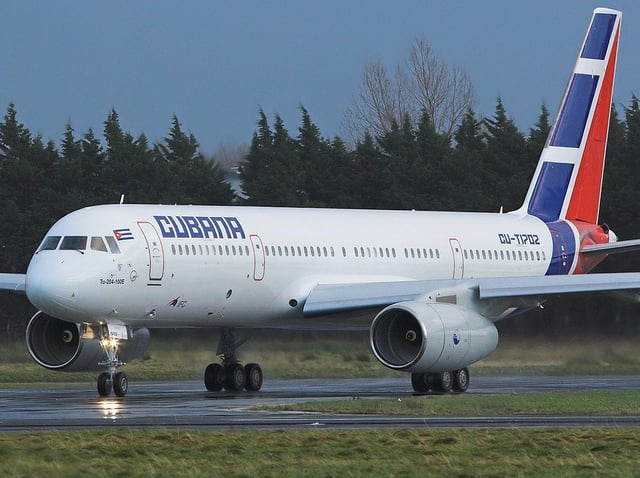
A Cubana Tupolev 204E in 2007.
The Tu-204 was designed as a family of aircraft incorporating passenger, cargo, combi and quick-change variants. It is powered by either two Aviadvigatel PS-90 or Rolls-Royce RB211 engines. The Tu-204 is produced at two of the largest Russian aircraft manufacturing plants in Ulyanovsk (Tu-204 series) and Kazan (Tu-214).[4]
Seating configuration is 3–3 in economy and 2-2 in Business class. The business class cabin has a seat pitch of 810 millimetres (31.9 in). The passenger cabin can be divided into compartments according to class with removable bulkheads and curtains. Compartments are illuminated by reflected light. Hidden lights located over and under the overhead bins create uniform and comfortable illumination. Overhead bins for passenger baggage and coats are of the closed type. The volume of baggage per passenger is 0.052 cubic metres (1.8 cu ft).[5]
In 1994, the first certificate for Tu-204 aircraft (with PS-90A engines) was issued. Subsequently, issued certificates have extended estimated operational conditions and improved overall aircraft type design. The Tu-204-120 variant, certified with Rolls-Royce RB211-535E4 engines, complies with noise regulations described in Chapter 3 of Supplement 16 to ICAO, hence meeting all current European and ICAO requirements.[6] It is currently undergoing the certification process with JAA. The Tu-204-100 variant, certified with PS-90A engines, complies with noise regulations described in Chapter 4 of Supplement 16 to ICAO which means it is quieter. The aircraft was certified to Russian standards AP-25 (harmonized with FAR-25 and JAR-25).[7]
Technology
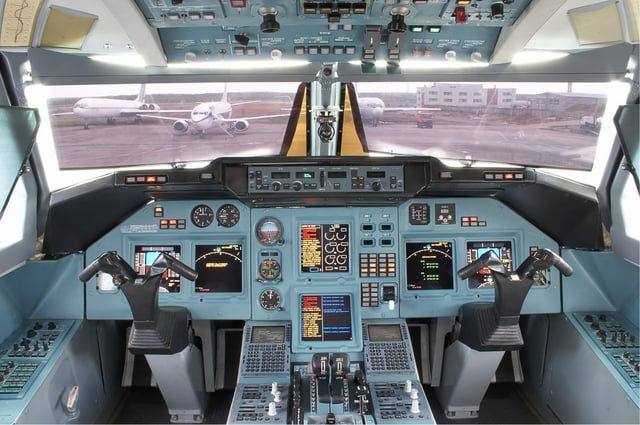
Cockpit of a Tu-214
The Tu-204 is part of a new generation of Russian aircraft, including other recent developments such as the Ilyushin Il-96. The Tu-204 features many technological innovations such as fly-by-wire control systems, a glass cockpit, supercritical wings with winglets, and is available with Russian or foreign avionics.[8] The wings and tails are relatively resistant to ice build-up, and as such anti-icing systems are not equipped. Among today's airliners the Tu-204 is the only one which does not require wing anti-icing systems. During the test flight safety has been confirmed without the anti-icing system on the bearing surfaces and the aircraft obtained Russian and European certificates.[9]
Variants
Tu-204/204C
The Tu-204 is the basic passenger airline model, and the Tu-204C is the basic freight or cargo model. The most-used models are the -100C and the -120C.[10]
Tu-204-100/200
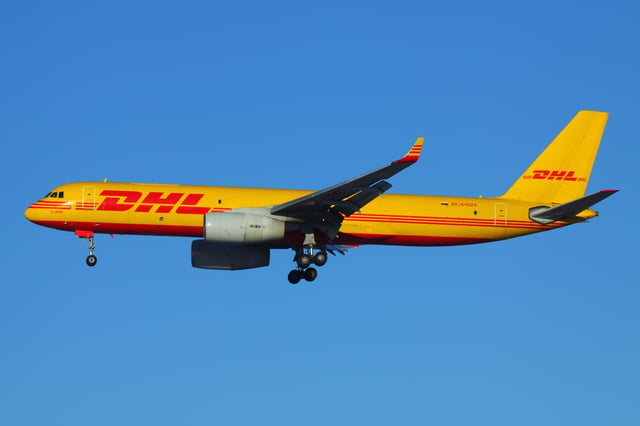
A Tupolev Tu-204C operated for DHL by Aviastar-TU at Sheremetyevo International Airport in Moscow, Russia.
Certified in January 1995, this initial version is powered by Soloviev (now Aviadvigatel) PS90 turbofans with 157 kN (35,300 lbf) of thrust, and uses Russian avionics in addition to its Russian engines. The Tu-204-200 is a heavier version with extra fuel for more range. Only one was built by Aviastar-SP in Ulyanovsk but has not yet been delivered (RA-64036). Now this version is only produced by KAPO in Kazan, marketed under the designation Tu-214. The Tu-204-100C and Tu-204-200C are cargo versions of the −100 and −200 respectively, fitted with a forward main deck freight door. Currently, the Tu-204-100/200 is offered with the option of an up-rated Aviadvigatel PS90A2 turbofan, which promises 40% more service between overhauls.[11]
The Tu-204-100's maximum take-off weight (MTOW) is 107.5 tonnes, and its range with 196 passengers in a two-class configuration is 6,000 kilometres (3,700 mi).
Tu-204-120/220/120C/220C
To broaden product appeal, the Tu-204-120/220 offers non-Russian avionics and engines. It is powered by two Rolls-Royce RB211-535 engines, each with thrust of 192 kN (43,100 lbf). Egypt's Cairo Aviation became the debut operator in November 1998 when it took delivery of a Tu-204-120 and its cargo version the Tu-204-120C. The Tu-204-220 and Tu-204-220C cargo version, are a higher gross weight variants of the basic Tu-204-120.[12]
The Tu-204-120 has a maximum takeoff weight of 103 metric tons and a range of 4,600 kilometres (2,500 nmi) with 196 passengers in a two-class seating configuration.
Tu-204-300
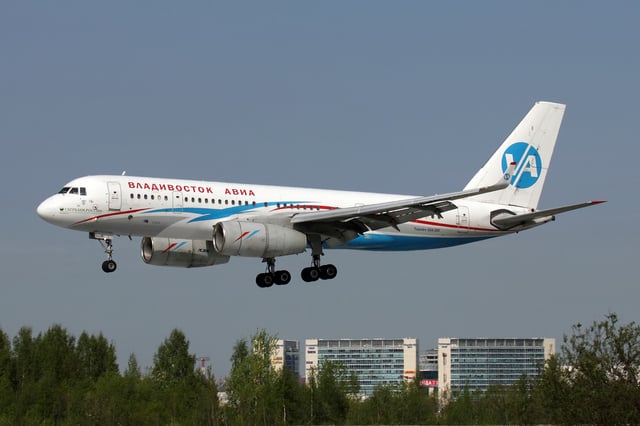
Vladivostok Air Tu-204-300 landing at Pulkovo Airport
A shortened, longer-range and more efficient derivative of the Tu-204, the Tu-204-300 is also known as Tu-234. About six meters (20 ft) shorter than the basic Tu-204, this variant is available in two versions: the longer-ranged, heavier version, powered by Aviadvigatel PS 90-A2 turbofans, has a maximum take-off weight of 107.5 metric tons and range (with 166 passengers) increased to 9,300 kilometres (5,000 nmi); and the lighter, shorter-ranged version, with a maximum take-off weight of 89 metric tons and range of 3,500 kilometres (1,900 nmi) with 166 passengers. The Russian airline Vladivostok Air is the debut customer. This airline's aircraft are in a two-class seating configuration, with a 142-passenger capacity. Average numbers of flight hours during each 24-hour period is 9.35 hours, for year 2009. It is also operated by Air Koryo which currently operates one Tu-204-100B and one Tu-204-300. The Тu-204s operate on the Pyongyang-Beijing, Bangkok, Vladivostok, Shenyang and Kuala Lumpur routes.[13]
Tu-204-500
This is a version of the Tu-204-300 optimized for shorter routes, featuring smaller wings and an increased cruising speed (to Mach 0.84), which makes it a competitor to the Next Generation Boeing 737. It is ETOPS rated, and fitted with a Honeywell 331-200ER APU.[14]
Tu-206
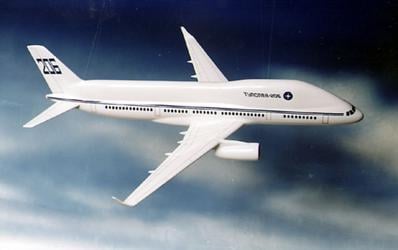
The planned experimental Tupolev Tu-206.
This variant is a company-funded testbed for alternative fuels, flying on liquefied natural gas.[15]
Tu-214
The Tu-214 is also a variation of the Tu-204 first flown on 21 March 1996.[16] It is technically a Tu-204-200, one of the differences being that it is built by a different factory. Planes designated Tu-204 are produced in Ulyanovsk by Aviastar-SP; Tu-214 in Kazan by the Kazan Aircraft Production Association (KAPO).[17][18] Both factories are independent from the Tupolev design bureau and have some control over the design of the variant they produce.
The main difference is a full-size main door at the left side of the fuselage just before the wing. The Tu-204 has two main doors and 2 emergency doors; the Tu-214 has 3 doors and one emergency door.
The Tu-214 is essentially a higher gross weight variant of the Tu-204, being fitted with extra fuel tanks and structural adjustments to deal with the heavier gross weight. For this reason, the Russian government prefers to use it as the platform upon which all further modifications for the 'Special Mission' variants will be based. Some of the special mission variants are disclosed to be capable of a non-stop 10,000-kilometre flight range.[19]
Tu-214ON
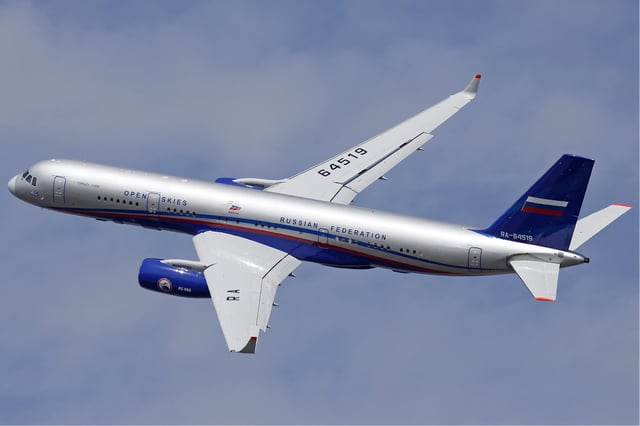
Russian Air Force Tu-214ON in flight.
The Tu-214ON is an observation version of the Tu-204-200, equipped for Treaty on Open Skies missions and built by Kazan Aircraft Production Association. Vega Radio Engineering Corporation was contracted for the development of airborne surveillance system, ground-based complex and other mission equipment for the aircraft. It is equipped with one A-84ON panoramic camera, one AK-111 topographic camera and two perspective AK-112 digital aerial cameras to capture high-resolution aerial photography.[21] Two video cameras, a Raduga infrared thermographic camera and Ronsard Side looking airborne radar are also fitted.[22]
The first Tu-214ON (RA-64519) was demonstrated at the MAKS-2011 international air show in Moscow. It performed its first test flight on 1 June 2011, which was followed by a series of 24 flights by December 2011. The Ministry of Defence of the Russian Federation conducted state tests to verify the air and ground equipment of the Tu-214ON aircraft in April 2013. The jet was delivered to the Russian Defence Ministry on 22 August 2013. The second airliner (RA-64525) made its first flight on 18 December 2013 and was delivered on 4 July 2014.[23] The Tu-214ON is set to replace the Tupolev Tu-154 and Antonov An-30 aircraft in the role.[24]
Tu-214SR
Tu-214R
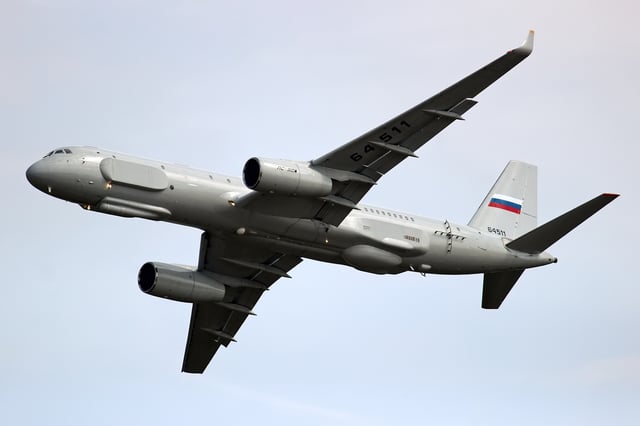
Tu-214R inflight from Borisoglebskoye airfield (2014)
Special-mission versions of the Tu-214 commercial transport aircraft, developed under the codename 'Project 141', to replace the Il-20 Coot ELINT platform. The aircraft are configured to carry the MRC-411 multi-intelligence payload, to include electronic intelligence (ELINT) sensors, side-looking Synthetic Aperture Radar (SAR) and other Signals Intelligence (SIGINT). In addition, the aircraft will carry multi-spectral electro-optical systems.[30] The aircraft has conducted test flights over the Sea of Japan but the programme experienced problems in January 2013. (Jane's Defence Weekly 16 January 2013)
As of January 2015, two were conducting test flights with the Russian Air Force.[33]
In July 2016, two flights have been reported to have been conducted near the Latvian, Estonian and Finnish borders, with the plane (registry reported as RA-64514) conducting close approaches a few dozen kilometers of the Finnish border on 5 and 7 July.[36]
After Syria operation, the aircraft was declared combat-ready. One plane was redeployed to Syria in summer 2016.[37]
Tu-214PU-SBUS
Special-purpose aircraft-control point equipped with a special onboard communication unit SBUS-214 intended for the Ministry of Defence of Russia. The aircraft is built with Russian-made components only, meeting the requirements of the state customers and has a range of at least 7,200 km (4,500 mi). The main purpose of the aircraft is to provide additional communication capabilities to the user.[38] The Russian MoD placed an order for two aircraft in November 2015.[39] The first aircraft was delivered in March 2018[40] while the second in June the same year.[41]
Tu-214LMK
A flying laboratory based on a serial Tu-214 passenger plane (registration number RA-64507) equipped with a multifunctional flight complex LMK-214. The aircraft is intended for an in-flight testing of a new radar complex and other on-board aviation equipment for the modernized Tupolev Tu-160M2 and the future Tupolev PAK DA strategic bombers. It began flight testing on 29 December 2018.[42]
Tu-204SM

Tupolev Tu-204SM.
The Tu-204SM, alternatively Tu-204CM,[43] a medium-range airliner, is an upgraded version of the Tu-204-100/300.[44][45] While the Tu-204SM will retain key design and aerodynamic features of the Tu-204-100/100E/100V series, there are numerous upgrades, largely aimed at meeting the current and near-future Russian and international standards, including those of ICAO and Eurocontrol.
The new cockpit features allow the Tu-204SM to be flown by a two-pilot crew (as compared with the three-pilot arrangement of the original Tu-204 series). These features include a new computer (VSUPT-85-2040), a new flight management system (ASO-204/FMS), wide LCD displays (KSEIS-204E), head-up displays (HUD), and an automated board system maintenance and diagnostic system. The electronic flight bag concept will be implemented and all controls and displays will be in English.
The Tu-204SM will be powered by two PS-90A2 engines. The latter is significantly improved over the original PS-90A power plants.[46] and features a unified twin-spool turbofan with a high bypass ratio. The PS-90A2 is expected a life cycle cost saving of 35% over the original engine with a simultaneous increase in reliability in the 50 to 100% range. The PS-90A2 is designed to meet the Russian AP-33 aviation standard, which is harmonized with the US FAR Part 33 and the European JAR33.
There will also be a new APU (TA-18 APU-200) and upgraded fuel management, hydraulic and fire safety systems.
The price for one Tu-204SM is estimated at USD 40–47 million.[47]
Tu-204SM orders
Red Wings Airlines will be the first airline to operate the Tu-204SM. Ilyushin Finance Co. (IFC) said it would complete negotiations with Red Wings for 44 Tu-204SM aircraft in February, to sign a firm order in March 2011. Red Wings already operates a fleet of Tu-204-100 and Tu-204-100V jetliners, to which it added one airframe in 2010.[48] Russia's largest aircraft lessor, Ilyushin Finance, has previously placed Tu-204-100 aircraft with Cubana, Air Koryo and Red Wings, and Tu-204-300s with Vladivostok Avia and Air Koryo. Additionally, IFC leases three Tu-214s (Tu-204-200s) to Transaero. Faced with low production rates for the Tu-204 models, Tupolev asked component providers to lower their prices in order to cut the plane's overall price by 27–30%. These suppliers agreed, on condition that 44 more firm orders be secured for the Tu-204SM through 2016.
By January 2012 a firm order from Red Wings had not been signed, the stumbling blocks being requests for guarantees of the residual value of the airframes and after-sales support at a cost the same as an equivalent Airbus or Boeing model.[49] It was subsequently announced that Red Wings had cut back its initial commitment from 44 to 15 Tu-204SMs due to delays to the flight-test programme and after the lessor Ilyushin Finance reportedly "lost interest".[50]
A large order by Iran Air Tours is under threat because of sanctions against the Iranian economy, as the American company Pratt & Whitney has been involved in the development of the engine with the Perm Engine Company. Completing the sale by re-equipping the Tu-204SMs with the Tu-204's Russian-made PS-90A engines has been proposed.[51]
At the Singapore Air Show in 2016 the Vice President of the Russian United Aircraft Corporation stated that every company that has ordered the Tu-204 has gone bankrupt so there currently no orders for the Tu-204SM, and Tupolev has frozen on development work on the aircraft and the UAC will withdraw it from their list of aircraft prices as soon as the Irkut MC-21 comes to the market.[52]
Operators
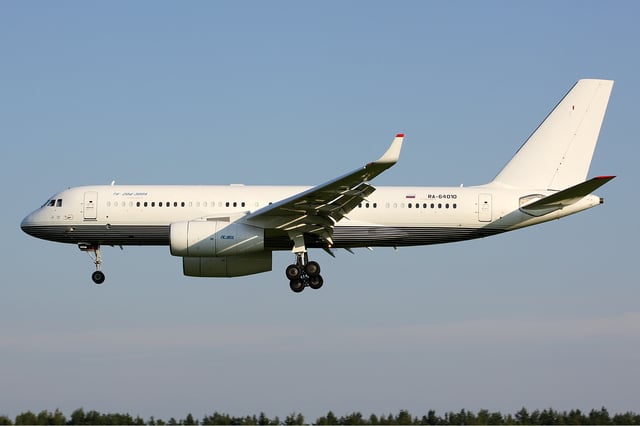
This Tu-204-300A is the first Tu-204 to be converted into a VIP configuration. Business Aero operates this aircraft for VTB
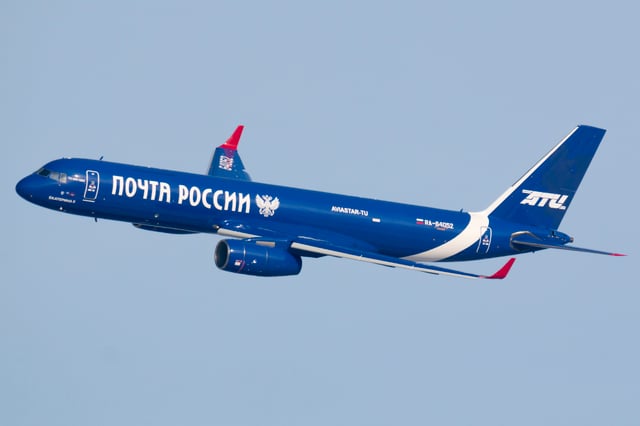
A Russian Post Tu-204-100C operated by Aviastar-TU
As of July 2018, there are 14 aircraft in commercial service.[20] Total users as of August 2019 include:
| Airline | Aircraft type | In service | On order | Stored |
|---|---|---|---|---|
| 204-120F | 0 | 4 | 0 | |
| 1 × 204-300 1 × 204-100 | 2 | 0 | 0 | |
| 204-100C | 1 | 0 | 1 | |
| 204 | 4 | 2 | 4 | |
| 204-300A | 1[53] | 0 | 0 | |
| 2 × 204-120C | 3 | 0 | 2 | |
| 204-120CE | 0 | 2 | 0 | |
| 1 × 204-100E | 3 | 0 | 1 | |
| 204-100 | 1 | 0 | 0 | |
| 204-300 | 2 | 0 | 0 | |
| 214 204-300 | 12 | 0 | 0 | |
| 204-100B | 1 | 0 | 0 | |
| 204-100E | 1 | 0 | 0 | |
| 214 | 2 | 0 | 0 | |
| 204-100C | 2[60] | 0 | 0 | |
| Total | All versions | 35 | 8 | 8 |
Previous operators
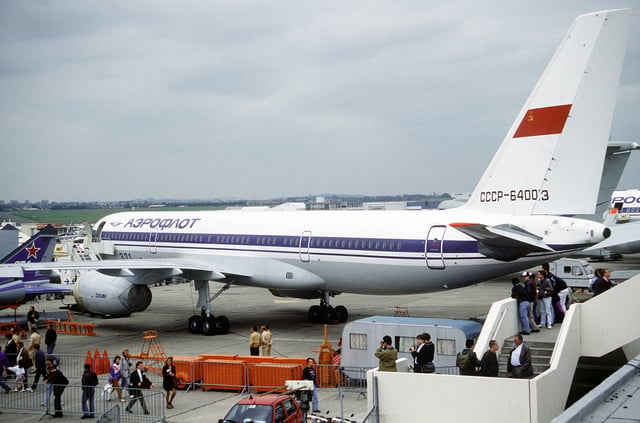
Aeroflot's previously operated Tupolev Tu-204 at the Paris Airshow
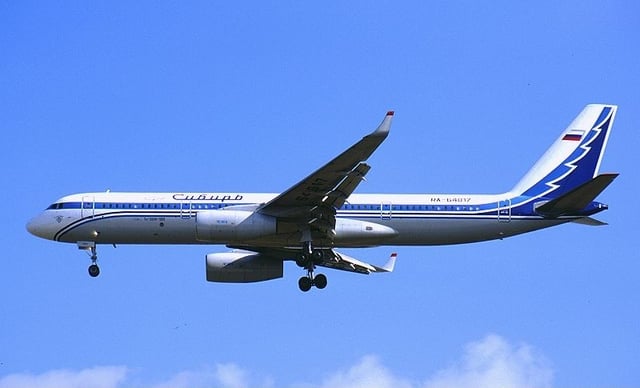
S7 Airlines (Siberia Airlines) previously operated Tupolev Tu-204
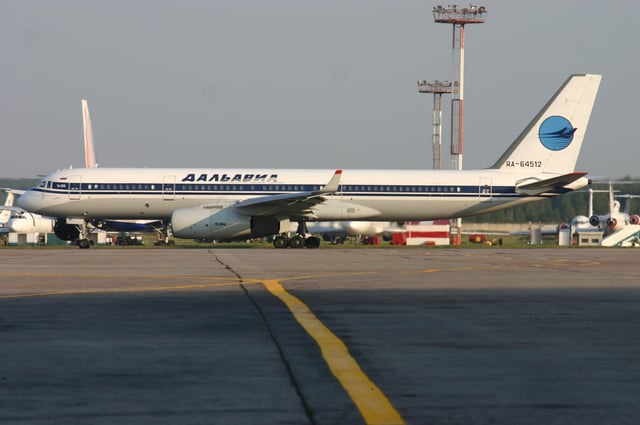
Dalavia previously operated Tupolev Tu-214
Production by year
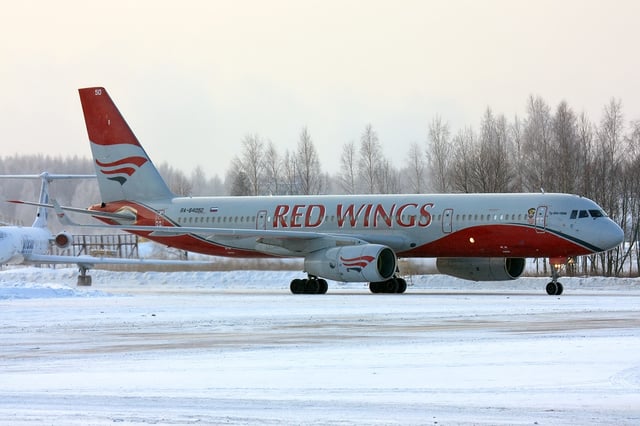
Red Wings Airlines, Tupolev Tu-204-100V.
| Year | 1989 | 1990 | 1991 | 1992 | 1993 | 1994 | 1995 | 1996 | 1997 | 1998 |
|---|---|---|---|---|---|---|---|---|---|---|
| Produced | 1 | 1 | 2 | 2 | 5 | 2 | 1 | 3 | 1 | 1 |
| Year | 1999 | 2000 | 2001 | 2002 | 2003 | 2004 | 2005 | 2006 | 2007 | 2008 |
|---|---|---|---|---|---|---|---|---|---|---|
| Produced | 2 | 4 | 3 | 4 | 4 | 2 | 3 | 4 | 2 | 10 |
| Year | 2009 | 2010 | 2011 | 2012 | 2013 | 2014 | 2015 | 2016 | 2017 | 2018 |
|---|---|---|---|---|---|---|---|---|---|---|
| Produced | 6 | 3 | 5 | 3 | 2 | 1 | 2 | 2 | 3 | 3 |
Specifications
| 204-100 | 204-120 | 214 | 204–300 | 204SM | |
|---|---|---|---|---|---|
| Cockpit crew | Three | Two | |||
| Seating capacity | 190 (1-class, standard) 172 (2-class, standard) 210 (maximum) | 210 (1-class, standard) 180 (2-class, standard) | 156 (1-class, standard) 142 (2-class, standard) | 194 (1-class, standard) 176 (2-class, standard) 215 (maximum) | |
| Seat pitch | 32 in (1-class, standard) 47 & 32 in (2-class, standard) | 32 in (1-class, standard) 39 & 32 in (2-class, standard) | 32 in (1-class, standard) 46 & 32 in (2-class, standard) | 32 in (1-class, standard) 38 & 32 in (2-class, standard) | |
| Length | 46.14 metres (151 ft 5 in) | 40.19 metres (131 ft 10 in) | 46.14 metres (151 ft 5 in) | ||
| Wingspan | 41.8 metres (137 ft 2 in) | ||||
| Wing area | 184.2 square metres (1,983 sq ft) | ||||
| Height | 13.9 metres (45 ft 7 in) | ||||
| Fuselage width | 3.8 metres (12 ft 6 in) | ||||
| Fuselage height | 4.1 metres (13 ft 5 in) | ||||
| Cabin width | 3.57 metres (11 ft 9 in) | ||||
| Cabin height | 2.16 metres (7 ft 1 in) | ||||
| Maximum take-off weight | 105,000 kilograms (231,000 lb) | 103,000 kilograms (227,000 lb) | 110,750 kilograms (244,160 lb) | 107,000 kilograms (236,000 lb) | 108,000 kilograms (238,000 lb) |
| Maximum landing weight | 88,000 kilograms (194,000 lb) | 93,000 kilograms (205,000 lb) | 88,000 kilograms (194,000 lb) | 89,500 kilograms (197,300 lb) | |
| Maximum payload | 21,000 kilograms (46,000 lb) | 25,200 kilograms (55,600 lb) | 18,000 kilograms (40,000 lb) | 23,000 kilograms (51,000 lb) | |
| Takeoff run at MTOW | 1,780 metres (5,840 ft) | 2,030 metres (6,660 ft) | 1,870 metres (6,140 ft) | 1,950 metres (6,400 ft) | |
| Service ceiling | 12,100 metres (39,700 ft) | 12,200 metres (40,000 ft) | |||
| Cruising speed | 810 to 850 km/h (500 to 530 mph) | ||||
| Maximum speed | 900 km/h (560 mph) | ||||
| Range (Max payload) | 4,300 kilometres (2,700 mi) | 4,100 kilometres (2,500 mi) | 4,340 kilometres (2,700 mi) | 5,800 kilometres (3,600 mi) | 4,200 kilometres (2,600 mi) |
| Maximum fuel capacity | 35,700 kilograms (78,700 lb) | 35,700 kilograms (78,700 lb) | 36,000 kilograms (79,000 lb) | 35,800 kilograms (78,900 lb) | |
| Engine (x 2) | Aviadvigatel PS-90A | Rolls-Royce RB211-535E4B | Aviadvigatel PS-90A or Rolls-Royce RB211-535E4B | Aviadvigatel PS-90A2 | |
| Max. thrust (x 2) | 157 kN 16,000 Kgf; 35,274 lbf | 192 kN 19,000 Kgf; 43,100 lbf | 158.2 kN 16,140 Kgf; 35,582 lbf | 171.6 kN 17,500 Kgf; 38,581 lbf | |
Accidents and incidents
On 22 March 2010, Aviastar-TU Flight 1906, an Aviastar Tupolev Tu-204 tail number RA-64011, crash-landed short of the runway near Moscow Domodedovo Airport while attempting to land at night in fog and poor visibility. There were no fatalities, but four of the eight crew members were seriously injured. It was a repositioning flight with no passengers on board. In September 2010, the МАК released their final report into the accident.[66] The cause of the accident was attributed to pilot error, with a number of factors contributing to the accident including inadequate crew training and lack of cockpit resource management, failure of autoflight systems and serious regulatory violations by Aviastar-TU. Eight years earlier, the same aircraft experienced a flameout of both engines, glided and overran the runway at Omsk Airport and sustained minor damage.
On 29 December 2012 at 16:35 local time (12:35 GMT), Red Wings Airlines Flight 9268, a Tupolev Tu-204-100В (RA-64047, c/n 1450743164047, s/n 047, built 2008) crashed on landing after overrunning runway 19 at Moscow Vnukovo International Airport (VKO) following a non-revenue repositioning flight originating from Pardubice Airport, Czech Republic. The aircraft broke up and came to a stop on elevated highway M3 about 400 meters (1,300 feet) past the runway's end. There were eight crew members on board of whom five were killed and the other three seriously injured.[67][68] Apart from those, one man driving his car on M3 highway was seriously injured when the detached Tu-204's nosewheel crashed into side of the car; the driver behind him recorded the impact on camera. The fatal Vnukovo accident was the second runway overrun incident involving a Red Wings operated Tu-204-100B in nine days following a Moscow Vnukovo to Novosibirsk flight on 20 December 2012 that overran runway 25 at Tolmachevo Airport by 1,150 feet (350 meters) into an open field.[69] Flight data recorder readouts indicate that brake failure as well as engine thrust reverser issues were major contributing causes in both overruns resulting in the issuance of additional airworthiness directives.[70][71][72][73]
On 22 August 2018, one of the Aviadvigatel PS-90 engines on a Red Wings TU-204 operating flight WZ808 from Ufa to Sochi experienced an engine surge during take off from Ufa International Airport and subsequently caught fire. The crew did not receive any fire indications, the automatic fire suppression system did not work, and the manual fire suppression failed to fully extinguish the flames. Emergency services put out the fire after landing while the passengers were evacuated through the right hand (emergency) doors via slides. There were no injuries. A Rosaviatsia (Russia's Civil Aviation Authority) commission has been set up to investigate the occurrence.[74]
See also
Aircraft industry of Russia
Related development
Tupolev Tu-154
Tupolev Tu-334
Aircraft of comparable role, configuration and era
Airbus A321
Boeing 737-900ER
Boeing 757
McDonnell Douglas MD-90
Related lists
List of jet airliners